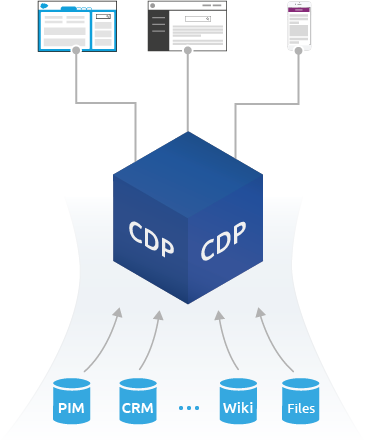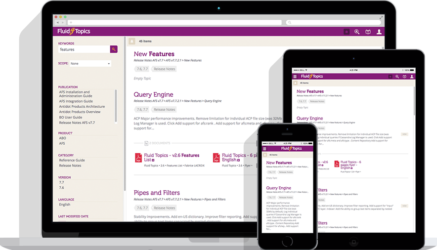Content Delivery Platform
Leveraging the most advanced content technologies, the Antidot Content Delivery Platform creates a repository of smart information and acts as a secure single point of delivery
What is a Content Delivery Platform?
A Content Delivery Platform is a software solution that collects content from existing sources, transforms this content into actionable information, and makes it accessible to applications and processes.

Collection
Content is fetched from various sources: textual documents, structured and unstructured records.
Transformation
To become actionable information, content is turned into fine-grained elements, enriched and reconciled.
Delivery
Applications and processes access information in a contextual and tailored way.
Optimization
Content consumption is analyzed to increase engagement proactivity.
Benefits
The CDP is complementing, rather than replacing or modifying, the authoring environments and other applications that are generating, storing and managing content. As these applications are usually designed for a specific purpose (CRM, helpdesk tools, Web CMS, wikis, file servers, etc.), they are not suited for fueling other channels by adapting the content to the target end-point.
The Content Delivery Platform solves this need and complexity of feeding other processes and applications with content originating from multiple sources:
It creates a single access point, one place to unify all information necessary to solve specific business challenges across the enterprise.
It brings consistency to content formats and metadata.
It applies security rules adapted to the delivery situations and to the profile of the users, controlled in a central manner.
It allows dissemination through multiple channels.

Core capabilities
A Content Delivery Platform is not just static content, pre-generated and dumped somewhere on a web server or in a database with a search engine on top. It goes far beyond this by applying business logic to deliver contextualized information that’s dynamically tailored to the user, the channel and the moment.
To manage this complexity, a Content Delivery Platform requires strong core capabilities and relies on technologically advanced components.

-
Ingest any type of content, either structured (from databases, knowledge bases, spare parts catalogs, etc.) or unstructured (PDFs, HTML, etc.). This requires a specific back-end for fetching and processing content, that is extensible (add more sources and content types as needed), programmable (APIs and scripting mechanisms to build processing pipelines), and manageable (tools to monitor jobs and check content validity).
-
Strong metadata management with the ability to extract metadata from content, to align (rewrite) metadata in order to make it consistent across sources, to automatically tag content (enrichment) by using advanced AI and machine learning-based algorithms, and to track metadata origin and changes for compliance.
-
Bulletproof content repository that serves content quickly and securely, scaling in all dimensions to cope with unlimited content volume and traffic increase. The content repository must provide APIs for easy integration, as well as multiple extensions, widgets and libraries for turnkey and channel-optimized integration.
-
Incredible search engine – full-text, faceted, semantic, secured, personalized and self-improving. Search is at the very center of the CDP and excellence is not an option.
-
Interact with content beyond reading, in order to capitalize on existing information. Features such as: bookmark, comment and annotate, reuse and personalize pieces of content, create alerts to be notified when content is published or modified, etc., are key elements of a modern engaging content delivery platform.
-
Embedded analytics system so that the CDP can learn from searches and user interaction, analyze content consumption in order to personalize search results and develop proactive content recommendation. The tight integration of analytics is certainly what makes the distinction between CDPs.
-
Integrate with enterprise security infrastructure to enforce access to content through dynamically configurable rules.
Domain-specific CDPs
Content Delivery Platforms can be specialized to specific business domains.
Packaged and pre-configured to ingest content from common sources and formats.
Metadata management scheme matching the business needs.
Connectors, turnkey apps and integration add-ons matching the environment for rapid deployment.
Fluid Topics is the most advanced CDP, dedicated to deliver product information in order to transform customer support, field maintenance, and boost client satisfaction.



